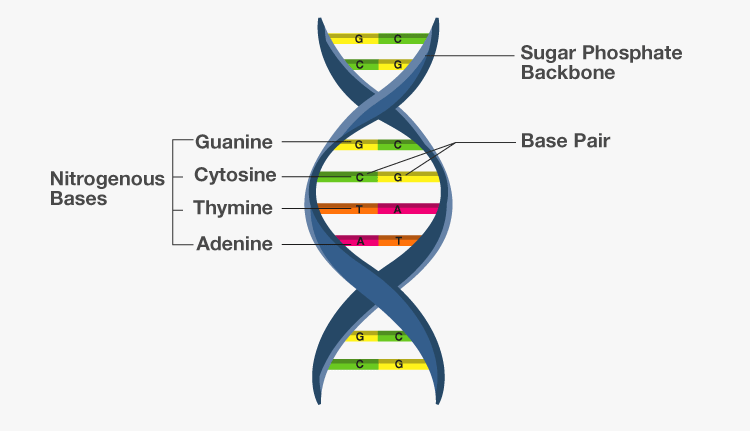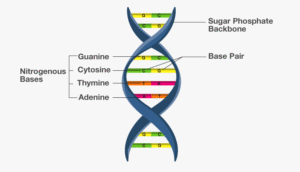
Introduction
- DNA, yaani Deoxyribonucleic Acid, ek fundamental molecule hai jo sabhi living organisms me genetic information carry karta hai, chhote bacteria se lekar complex plants aur animals tak, including humans.
- Isko aksar “life ka blueprint” kaha jata hai, kyunki yeh organisms ke growth, development, functioning, aur reproduction ke liye instructions provide karta hai.

Features OF DNA:
-
Chemical Composition:
DNA ek polymer hai jo repeating units, yaani nucleotides, se bana hota hai. Har nucleotide mein teen cheezein hoti hain:-
Phosphate group
-
Deoxyribose sugar
-
Nitrogenous base (Adenine (A), Thymine (T), Cytosine (C), ya Guanine (G))

-
-
Double Helix Structure:
DNA molecule do long strands se bana hota hai jo double helix (do spiral shapes) banate hain. Ye strands complementary base pairs se judte hain:-
Adenine (A) Thymine (T) se pair karta hai
-
Cytosine (C) Guanine (G) se pair karta hai
Ye structure 1953 me James Watson aur Francis Crick ne discover kiya tha, based on Rosalind Franklin ke X-ray crystallography data.
-
-
Genetic Code:
Nitrogenous bases (A, T, C, G) ki sequence hi wo genetic instructions hai jo organism ke development ko guide karti hai. Teen bases ka ek specific sequence, codon, ek specific amino acid ko code karta hai, jo proteins banane ke liye use hota hai. -
Location in Cells:
-
Eukaryotic cells me DNA primarily nucleus mein hota hai aur chromosomes mein organized hota hai.
-
Prokaryotic cells (jaise bacteria) me DNA cytoplasm mein hota hai aur yeh usually ek circular DNA molecule hota hai.
-
Mitochondria (animal aur plant cells mein) aur chloroplasts (plant cells mein) mein bhi thoda DNA hota hai.
-
-
Replication:
DNA apne aap ko replicate kar sakta hai, jisse genetic information next generation tak pass hoti hai jab cells divide karte hain. Yeh process kaafi accurate hota hai, lekin isme kai enzymes (jaise DNA polymerase) involved hote hain, aur kai steps hote hain jaise DNA ka unwind hona, strands ka copy hona, aur errors ka proofreading.
Classification of DNA
Seven Criteria for DNA Classification:
-
Number of Base Pairs per Turn:
DNA ke helical structure mein ek complete turn (twist) banane ke liye kitne base pairs chahiye. Example ke liye, B-DNA mein 10 base pairs per turn hote hain, lekin yeh number alag forms mein vary kar sakta hai (jaise A-DNA aur Z-DNA). -
Coiling Pattern:
DNA strands ek dusre ke around kis tarah se coil karte hain.-
B-DNA sabse common coiling pattern hai, jo ek right-handed helix banata hai.
-
A-DNA aur Z-DNA bhi hote hain jo alag tarah se coiled hote hain.
-
-
Location:
DNA ko uske location ke hisaab se classify kiya ja sakta hai:-
Nuclear DNA: Eukaryotic cells mein nucleus mein hota hai.
-
Mitochondrial DNA: Mitochondria mein hota hai.
-
Chloroplast DNA: Plant cells ke chloroplasts mein hota hai.
-
Plasmid DNA: Bacteria aur kuch eukaryotes mein hota hai, yeh small circular form mein hota hai.
-
Prokaryotic DNA: Bacteria ke cytoplasm mein hota hai aur usually ek circular chromosome hota hai.
-
-
Structure:
DNA ko uske structural form ke hisaab se classify kiya ja sakta hai:-
Linear DNA: Eukaryotic chromosomes mein straight strands hote hain.
-
Circular DNA: Prokaryotes aur mitochondria mein closed loop form mein hota hai.
-
Supercoiled DNA: Prokaryotes aur nucleus mein DNA supercoiled hota hai, jisse space bachaya ja sakta hai aur gene expression regulate hota hai.
-
-
Nucleotide Sequences:
Nitrogenous bases ki sequence hi determine karti hai ki DNA ka genetic information kya hai.-
Unique DNA sequences: Functional genes aur regulatory regions mein paye jate hain.
-
Repetitive DNA sequences: Satellite DNA jaise repetitive sequences jo proteins ko code nahi karte lekin structural aur regulatory roles mein involved hote hain.
-
-
Coding and Non-Coding DNA:
-
Coding DNA: Yeh wo DNA hai jo genes ko contain karta hai, jo proteins ke liye code karte hain.
-
Non-Coding DNA: Yeh wo DNA hai jo proteins ko code nahi karta lekin regulatory aur structural roles play karta hai.
-
Exons: Coding regions jo express hote hain.
-
Introns: Non-coding regions jo genes ke andar hote hain.
-
Regulatory regions: Genes ke expression ko control karte hain.
-
Satellite DNA: Repetitive sequences jo chromosomes ki structure ko maintain karte hain.
-
-
-
Number of Strands:
DNA single-stranded ya double-stranded ho sakta hai:-
Double-Stranded DNA (dsDNA): Yeh typical structure hai jisme do complementary strands ek double helix banate hain.
-
Single-Stranded DNA (ssDNA): Kuch viruses mein aur DNA replication aur transcription jaise processes mein intermediate form hota hai.
-
Structure of DNA
DNA ka structure uski function ko define karta hai, jo hai genetic information ko store karna, cellular activities ko guide karna, aur reproduction ko enable karna. Yeh structure simple hai, lekin highly organized hai, aur isko double helix kaha jata hai.
-
Basic Components of DNA:
DNA ek long molecule hai jo repeating units (nucleotides) se bana hota hai. Har nucleotide mein teen cheezein hoti hain:-
Phosphate group
-
Deoxyribose sugar (yeh backbone banata hai)
-
Nitrogenous base (Adenine (A), Thymine (T), Cytosine (C), ya Guanine (G))

-
-
Double Helix:
DNA double-stranded hota hai jo ek spiral shape mein twisted hota hai. Do complementary strands ek dusre ke saath hydrogen bonds ke through judte hain. Yeh anti-parallel hote hain, matlab ek strand 5′ to 3′ direction mein chal raha hota hai, aur doosra strand 3′ to 5′ direction mein. -
Base Pairing:
Adenine (A) Thymine (T) se aur Cytosine (C) Guanine (G) se pair karte hain, aur yeh complementary base pairing ensure karti hai ki genetic code accurately copy ho. -
Major and Minor Grooves:
Double helix ke beech jo gaps bante hain unhe grooves kaha jata hai. Major groove bada gap hota hai, aur minor groove chhota gap hota hai. Yeh grooves regulatory proteins aur enzymes ke liye important hain. -
Helical Structure:
Double helix ek right-handed helix hota hai, jo clockwise direction mein twist hota hai. -
DNA Packaging:
DNA ko eukaryotic cells mein chromosomes mein pack kiya jata hai. Yeh histone proteins ke around wrap hota hai aur nucleosomes banata hai. -
DNA Replication and Repair:
DNA apne aap ko replicate karne mein capable hai. Is process mein DNA ki strands separate hoti hain, aur har strand ek complementary strand banata hai. Yeh process DNA polymerase se accurate hota hai, aur DNA repair mechanisms bhi exist karte hain jo damaged bases ko fix karte hain.
Function of DNA
DNA ka main function organism ki genetic information ko store karna, usse replicate karna, aur organism ke various functions ko regulate karna hai. Yahaan DNA ke kuch important functions diye gaye hain:
-
Genetic Information Store Karna:
DNA organism ki saari genetic information ko store karta hai, jo uske development, growth, aur functioning ke liye zaroori hoti hai. Yeh information proteins banane ki instructions rakhti hai jo body ki activities ko perform karte hain. -
Replication (Apne aap ko Replicate Karna):
Jab cells divide karte hain, DNA apne aap ko replicate karta hai. Iska matlab hai ki har new cell ko original cell ka same genetic information milta hai. DNA replication ka process bahut accurate hota hai, jisme enzymes jaise DNA polymerase madad karte hain. -
Proteins Banane ke liye Instructions Dena:
DNA cells ko proteins banane ki instructions deta hai. Proteins body mein har kaam karte hain jaise tissue ka banana, cell repair karna, aur chemical reactions ko speed up karna. Yeh proteins humari body ke proper functioning ke liye essential hote hain. -
Traits ko Offspring Tak Pass Karna:
DNA parents se offspring tak genetic information ko pass karta hai. Isse offspring ko apne parents ke traits (jaise eye color, height, etc.) inherit hote hain. Is process ko inheritance kehte hain. -
Mutations Aur Evolution:
Kabhi kabhi DNA mein changes hote hain (mutations), jo new traits create karte hain. In changes ke through organisms apne environment ke hisaab se adapt karte hain, aur yeh evolution ke process ka part hote hain. -
Body Functions ko Regulate Karna:
DNA decide karta hai ki kis gene ko kab aur kitni baar express karna hai. Yeh process cell functions ko control karta hai, jaise genes ko activate karna ya deactivate karna. Isse body ke different processes regulate hote hain, jaise growth, metabolism, aur immune response. -
DNA Repair Karna:
DNA mein agar koi damage hota hai to body mein repair mechanisms hoti hain jo usse theek kar leti hain. Yeh process mistakes ya mutations ko fix karne mein help karti hai aur cells ko protect karti hai. -
Chromosomes ko Protect Karna:
DNA ke ends par special protective caps hote hain jise telomeres kehte hain. Yeh telomeres chromosomes ko damage hone se bachate hain jab cells divide karte hain.